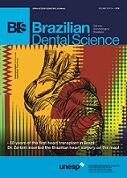Evaluation of dimensional stability and details reproduction of alginate molds storage in different times and temperature
DOI:
https://doi.org/10.14295/bds.2018.v21i1.1501Abstract
Objective: The aim of this study was to evaluate dimensional stability and detail reproduction in alginate molds stored at different times and temperatures. Material and Methods: Three different commercially available alginates (Cavex Color Change, Jeltrate Plus and Hydrogum 5) were tested at four different times (0 - control, 1, 3 and 5 days) and two temperatures (25ºC and 37ºC) (n=5). The alginates were handled following the manufacturer's instructions. The impression procedures occurred in an environment with controlled room temperature (25ºC) and relative humidity (50±5%). A metallic model (ISO 1563:1990) was used to perform the impressions. The tray containing alginate remained on the metallic model under constant pressure (2 kgf) until the alginate gelation process. The molds were stored (different times and temperatures) and analyzed in stereomicroscope at 30x magnification and 0.5 ?m accuracy (Olympus Measuring Microscope STM). The molds and the metallic model measurements were compared, and the data were statistically analyzed by Kolmogorov-Smirnov and three-way ANOVA tests, and the means were compared by Tukey test (5%). Results: The results showed no double interactions (p>0.05) and the different alginates presented statistically similar values of dimensional stability (p=0.102). However, 25ºC (temperature) and control group (time) showed the highest values of dimensional stability (p<0.05). Jeltrate Plus was the only material that presented inaccuracy in details reproduction. Conclusion: It is recommended that, for tested alginates, the stone casts should be poured immediately, even though the molds are dimensionally stable up to 5 days when stored at 25ºC.
Keywords
Dental impression materials; Dimensional measurement accuracy; Shrinkage.
Downloads
Downloads
Additional Files
Published
How to Cite
Issue
Section
License
Brazilian Dental Science uses the Creative Commons (CC-BY 4.0) license, thus preserving the integrity of articles in an open access environment. The journal allows the author to retain publishing rights without restrictions.
=================




























